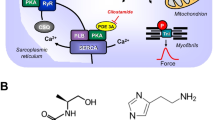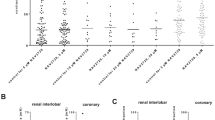Summary
5-Hydroxytryptamine (5-HT)-induced contractions were investigated in isolated tracheal smooth muscle of guinea pig and calf. In guinea-pig tracheae, ketanserin reduced to 60% the maximum response to 5-HT, but also shifted the concentration-effect curve for 5-HT to higher 5-HT concentrations, as expected from its affinity for 5-HT2 receptors [pK B=−log K B=9.6, K B in mol/l]. The concentration effect-data for the depressant effect of ketanserin are closely associated with the curve for occupancy of 5-HT2-receptors by ketanserin. In calf tracheae, ketanserin caused surmountable antagonism of the effects of 5-HT with a pK B of 9.5. Methysergide reduced to 25% the maximum response to 5-HT in guinea-pig tracheae and to 20% in calf tracheae. The methysergide-depressed response to 5-HT was restored by ketanserin to 60% of maximum in guinea-pig tracheae, and to 100% in calf tracheae. The results support for tracheal smooth muscle a model of an allosteric regulation of 5-HT2-receptors which was proposed for arterial smooth muscle by Kaumann and Frenken (this journal 328:295–300, 1985). The model requires that: 1) the 5-HT2 receptor exists in two interconvertible states R⇌R′;2) 5-HT causes its effects through R; 3) methysergide, by acting on an allosteric site near or on the 5-HT2 receptor, shifts the equilibrium into the inactive state R′;4) ketanserin competes with 5-HT for the 5-HT2 receptor and with methysergide for the allosteric site, thereby restoring the active state R of the 5-HT2-receptor. All four requirements were experimentally verified in calf trachea. In guinea-pig trachea ketanscrin also appears to possess a partial ability to shift the 5-HT2 receptor into the inactive R′ state. Thus, ketanserin is both a competitive antagonist at the 5-HT2 receptor and also appears to be an allosteric modulator at the allosteric site.
Similar content being viewed by others
References
Arunlakshana O, Schild HO (1959) Some quantitative uses of drug antagonism. Br J Pharmacol 14:48–58
Ball HA, Parrat JR, Rodger IW (1983) The effect of a selective 5-HT2 antagonist, ketanserin, on the pulmonary responses to Escherichia coli endotoxin. Br J Pharmacol 80:295–301
Blinks JR (1965) Convenient apparatus for recording contractions of isolated heart muscle. J Appl Physiol 20:755–757
Chand N, DeRoth L, Eyre P (1979) Relaxant response of goat trachea to 5-hydroxytryptamine mediated by D-tryptamine receptors. Br J Pharmacol 66:331–336
Cohen ML, Schenk KW, Colbert W, Wittenauer L (1985) Role of 5-HT2 receptors in serotonin-induced contractions of nonvascular smooth muscle. J Pharmacol Exp Ther 232:770–774
Erspamer V (1965) Peripheral physiological and pharmacological actions of indole alkylamines. In: Ersparmer V (ed) Handbook of experimental pharmacology, vol 14, 5-Hydroxytryptamine and related indolalkylamines. Springer, Berlin Heidelberg New York, pp 245–359
Frenken M, Kaumann AJ (1984a) Interaction of ketanserin and its metabolite ketanserinol with 5-HT2 receptors in pulmonary and coronary arteries of calf. Naunyn-Schmiedeberg's Arch Pharmacol 326:334–339
Frenken M, Kaumann AJ (1984b) Interconversion between two 5-HT2-receptor states in large coronary artery (CA) of calf. Proceedings of the 9th International Congress of Pharmacology, London UK, p 170P
Frenken M, Kaumann AJ (1985a) Tryptamine interacts with both the 5-HT2 receptor and an allosteric site in bovine large coronary artery. Pflügers Arch 403: R 32
Frenken M, Kaumann AJ (1985b) Protection of the 5-HT2 receptor against irreversible occlusion by interconversion into its isomeric R′ state. Naunyn-Schmiedeberg's Arch Pharmacol 330:R 64
Kaumann AJ (1983) Yohimbine and rauwolscine inhibit 5-hydroxytryptamine-induced contraction of large coronary arteries of calf through blockade of 5-HT2 receptors. Naunyn-Schmiedeberg's Arch Pharmacol 323:149–154
Kaumann AJ, Frenken M (1985) A paradox: The 5-HT2 receptor antagonist ketanserin restores the 5-HT-induced contraction depressed by methysergide in large coronary arteries of calf. Allosteric regulation of 5-HT2 receptors. Naunyn-Schmiedeberg's Arch Pharmacol 328:295–300
Kaumann AJ, Frenken M, Lemoine H (1985) Allosteric regulation of 5-RT2 receptors in smooth muscle. Naunyn-Schmiedeberg's Arch Pharmacol 330:R 64
Leysen JE, Niemegeers CJE, Van Nueten JM, Laduron PM (1982) [3H]Ketanserin (R 41468), a selective 3H-ligand for serotonin2 receptor binding sites. Binding properties, brain distribution and functional role. Mol Pharmacol 21:301–314
Peroutka ST, Snyder SH (1979) Multiple serotonin receptors: Differential binding of (3H)5-hydroxytryptamine, (3H) lysergic acid diethylamine and (3H) spiroperidol. Mol Pharmacol 16:687–699
Van Nueten JM, Leysen JE, Vanhoutte PM, Janssen PAS (1982) Serotonergic responses in vascular and nonvascular tissues. Arch Int Pharmacodyn 256:331–334
Walter M, Lemoine H, Kaumann AJ (1984) Optical isomers of pindolol on the sinoatrial node and trachea of guinea pig.Role of β-adrenoceptor subtypes in the dissociation between blockade and stimulation. Naunyn-Schmiedeberg's Arch Pharmacol 327:159–175
Author information
Authors and Affiliations
Rights and permissions
About this article
Cite this article
Lemoine, H., Kaumann, A.J. Allosteric properties of 5-HT2 receptors in tracheal smooth muscle. Naunyn-Schmiedeberg's Arch. Pharmacol. 333, 91–97 (1986). https://doi.org/10.1007/BF00506509
Received:
Accepted:
Issue Date:
DOI: https://doi.org/10.1007/BF00506509




